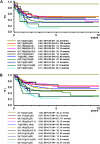Novel prognostic subgroups in childhood 11q23/MLL-rearranged acute myeloid leukemia: results of an international retrospective study
- PMID: 19528532
- PMCID: PMC2927031
- DOI: 10.1182/blood-2009-04-215152
Novel prognostic subgroups in childhood 11q23/MLL-rearranged acute myeloid leukemia: results of an international retrospective study
Abstract
Translocations involving chromosome 11q23 frequently occur in pediatric acute myeloid leukemia (AML) and are associated with poor prognosis. In most cases, the MLL gene is involved, and more than 50 translocation partners have been described. Clinical outcome data of the 11q23-rearranged subgroups are scarce because most 11q23 series are too small for meaningful analysis of subgroups, although some studies suggest that patients with t(9;11)(p22;q23) have a more favorable prognosis. We retrospectively collected outcome data of 756 children with 11q23- or MLL-rearranged AML from 11 collaborative groups to identify differences in outcome based on translocation partners. All karyotypes were centrally reviewed before assigning patients to subgroups. The event-free survival of 11q23/MLL-rearranged pediatric AML at 5 years from diagnosis was 44% (+/- 5%), with large differences across subgroups (11% +/- 5% to 92% +/- 5%). Multivariate analysis identified the following subgroups as independent prognostic predictors: t(1;11)(q21;q23) (hazard ratio [HR] = 0.1, P = .004); t(6;11)(q27;q23) (HR = 2.2, P < .001); t(10;11)(p12;q23) (HR = 1.5, P = .005); and t(10;11)(p11.2;q23) (HR = 2.5, P = .005). We could not confirm the favorable prognosis of the t(9;11)(p22;q23) subgroup. We identified large differences in outcome within 11q23/MLL-rearranged pediatric AML and novel subgroups based on translocation partners that independently predict clinical outcome. Screening for these translocation partners is needed for accurate treatment stratification at diagnosis.
Figures


Comment in
-
T(11q23): brand necessary.Blood. 2009 Sep 17;114(12):2365-6. doi: 10.1182/blood-2009-07-229914. Blood. 2009. PMID: 19762500 No abstract available.
References
-
- Kaspers GJ, Zwaan CM. Pediatric acute myeloid leukemia: towards high-quality cure of all patients. Haematologica. 2007;92:1519–1532. - PubMed
-
- Grimwade D, Walker H, Oliver F, et al. The importance of diagnostic cytogenetics on outcome in AML: analysis of 1,612 patients entered into the MRC AML 10 trial. The Medical Research Council Adult and Children's Leukaemia Working Parties. Blood. 1998;92:2322–2333. - PubMed
-
- Raimondi SC, Chang MN, Ravindranath Y, et al. Chromosomal abnormalities in 478 children with acute myeloid leukemia: clinical characteristics and treatment outcome in a cooperative pediatric oncology group study-POG 8821. Blood. 1999;94:3707–3716. - PubMed
-
- Lie SO, Abrahamsson J, Clausen N, et al. Treatment stratification based on initial in vivo response in acute myeloid leukaemia in children without Down's syndrome: results of NOPHO-AML trials. Br J Haematol. 2003;122:217–225. - PubMed
-
- von Bergh A, Emanuel B, van Zelderen-Bhola S, et al. A DNA probe combination for improved detection of MLL/11q23 breakpoints by double-color interphase-FISH in acute leukemias. Genes Chromosomes Cancer. 2000;28:14–22. - PubMed
Publication types
MeSH terms
Substances
Grants and funding
LinkOut - more resources
Full Text Sources
Other Literature Sources
Medical
Research Materials

